
ECODESIGN
LIGHTING PRODUCTS IN THE DOMESTIC AND TERTIARY SECTORS
Exigencies for ecodesign for electric motors were stated in the
‘Commission Regulation (EC) No 245/2009 of 18 March 2009 implementing Directive 2005/32/EC of the European Parliament and of the Council with regard to ecodesign requirements for fluorescent lamps without integrated ballast, for high intensity discharge lamps, and for ballasts and luminaires able to operate such lamps, and repealing Directive 2000/55/EC of the European Parliament and of the Council’ and ‘Commission Regulation (EC) No 244/2009 of 18 March 2009 implementing Directive 2005/32/EC of the European Parliament and of the Council with regard to ecodesign requirements for non-directional household lamps’
Which were later amended by
‘Commission Regulation (EU) No 347/2010 of 21 April 2010 amending Commission Regulation (EC) No 245/2009 as regards the ecodesign requirements for fluorescent lamps without integrated ballast, for high intensity discharge lamps, and for ballasts and luminaires able to operate such lamps’ and ‘Commission Regulation (EC) No 859/2009 of 18 September 2009 amending Regulation (EC) No 244/2009 as regards the ecodesign requirements on ultraviolet radiation of non-directional household lamps’
Requirements for fluorescent and high intensity discharge lamps and ballasts as well as luminaires able to operate such lamps are following:
• Lamp efficiency requirements:
- One year after the ‘Commission Regulation (EC) No 245/2009 of 18 March 2009’ has come into force the luminous efficiencies of the following lamps shall not be less than values stated in the tables.
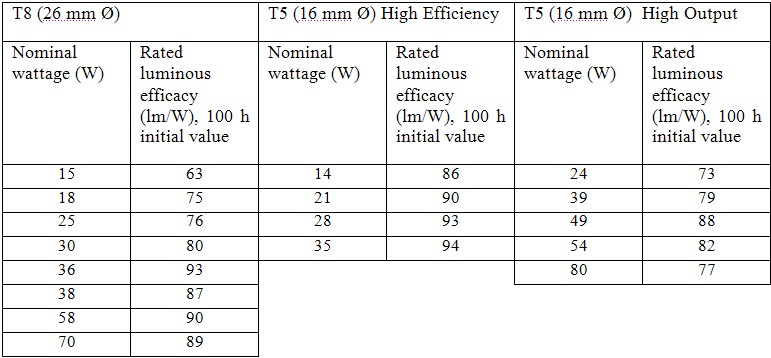
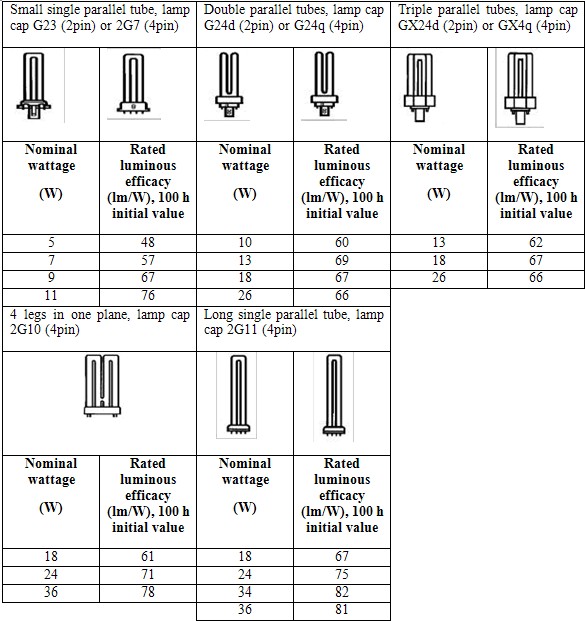
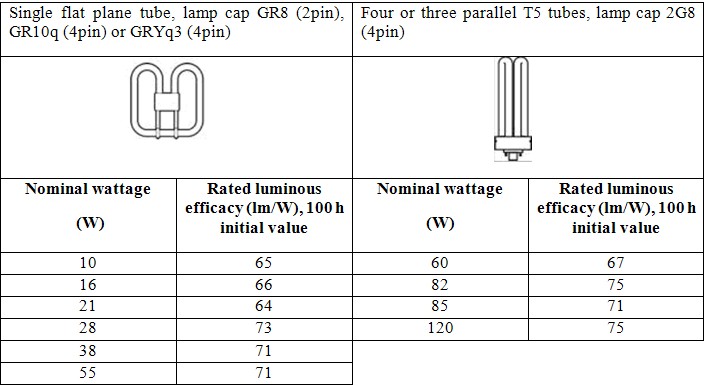
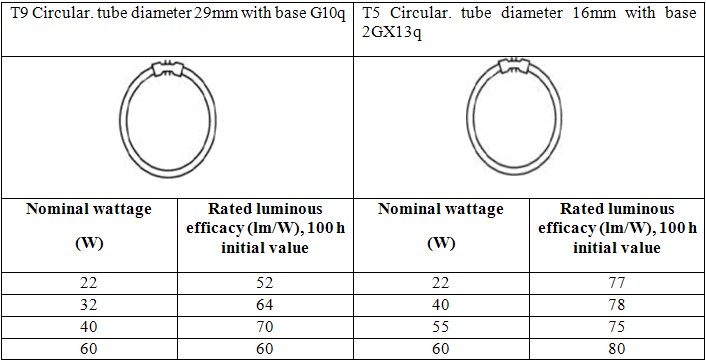
Required minimum luminous efficacy values for both single and double capped fluorescent lamps can be lowered at 25C in the following cases:
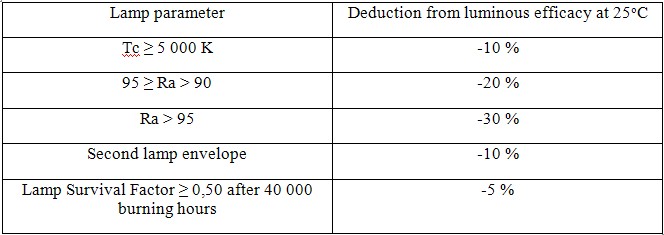
- three years after the ‘Commission Regulation (EC) No 245/2009 of 18 March 2009’ has come into force the luminous efficiencies of the following lamps shall not be less than values stated in the tables. Also the requirements applicable to double capped fluorescent lamps 26 mm in diameter (T8) during the first stage shall apply to all double capped fluorescent lamps of other diameters than those covered in the first stage.
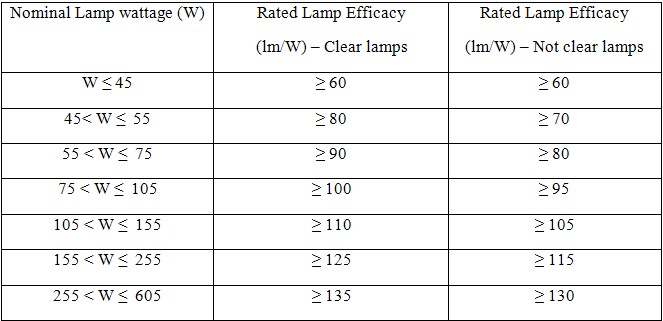
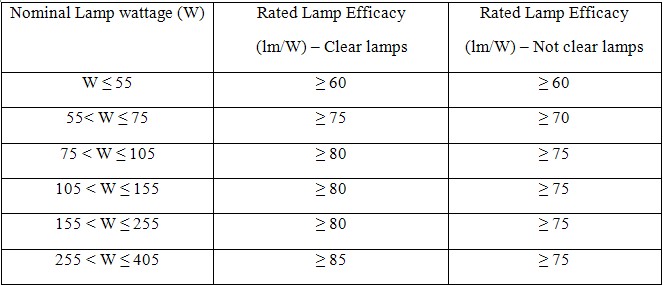

- Eight years after the ‘Commission Regulation (EC) No 245/2009 of 18 March 2009’ has come into force the luminous efficiencies of the following lamps shall not be less than values stated in the table.
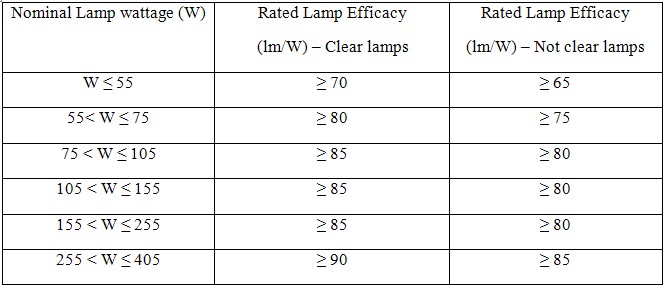
• Lamp exploitation requirements:
- One year after the ‘Commission Regulation (EC) No 245/2009 of 18 March 2009’ has come into force all the fluorescent lamps without inbuilt ballast shall have a color rendering index (Ra) of at least 80.
- Three years after the ‘Commission Regulation (EC) No 245/2009 of 18 March 2009’ has come into force all the fluorescent lamps without inbuilt ballast shall have a color rendering index (Ra) of at least 80 and the lamp lumen maintenance factor higher than in the following table.
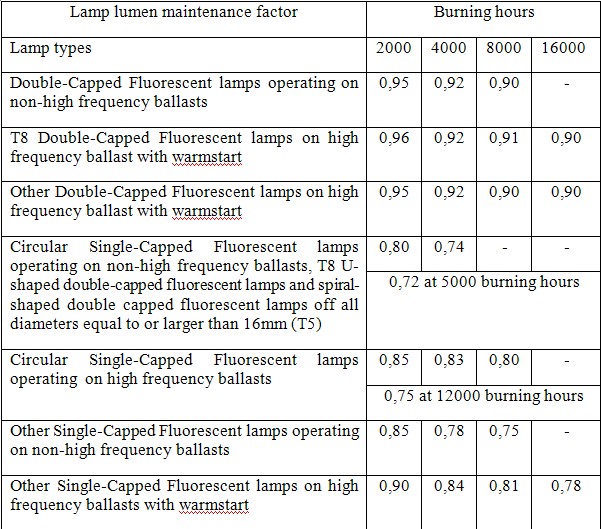
Fluorescent lamps without inbuilt ballast shall also satisfy the minimum lamp survival factors shown in the following table.
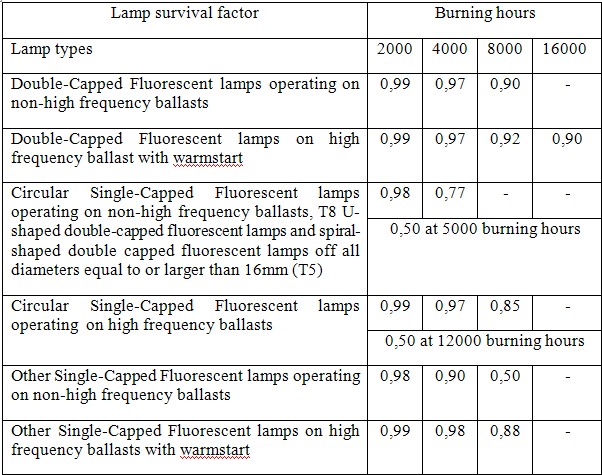
High pressure sodium lamps shall also satisfy the following requirements concerning lamp lumen maintenance and survival factors.
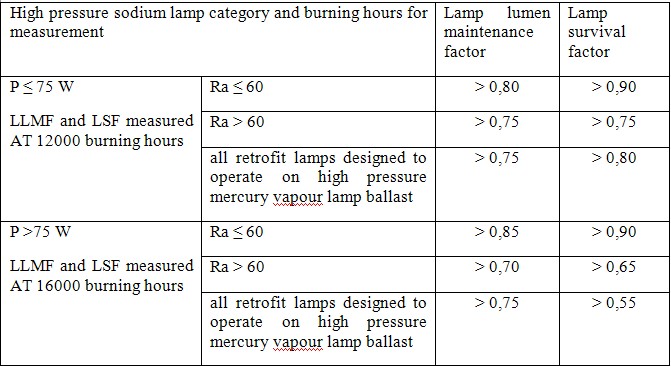
- Eight years after the ‘Commission Regulation (EC) No 245/2009 of 18 March 2009’ has come into force all the metal halide lamps shall satisfy following requirements.

• Requirements concerning information about lamps:
- One year after the ‘Commission Regulation (EC) No 245/2009 of 18 March 2009’ has come into force the lamps producers shall provide the following information on generally available internet web pages or any other appropriate media about their fluorescent lamps without integrated ballast and each of their high intensity discharge lamps. Also the same information shall be delivered in the technical documentation with the product.
• Rated and nominal wattage.
• Rated and nominal luminous flux.
• Rated luminous efficacy after 100 hours at 25C and 35C for T5 lamps. For fluorescent lamps both at 50Hz and higher frequencies. For higher frequencies the value shall be provided with the calibration current of the test conditions and/or with the rated voltage of the high frequency generator with its resistance. The information that the power dissipated byauxiliary equipment such as ballasts is not counted shall be provided as well.
• Rated lumen maintenance factor after 2000h, 4000h, 6000h, 8000h, 12000h, 16000h, 20000h (up to 8000h only for new type lamps where no data is yet available).
• Rated lamp survival factor after 2000h, 4000h, 6000h, 8000h, 12000h, 16000h, 20000h (up to 8000h only for new type lamps where no data is yet available).
• Mercury occurrence as [x.x mg].
• Color rendering index (Ra) of the lamp.
• Color temperature of the lamp.
• Ambient temperature at which the lamp achieves the most efficient luminous flux.
• Requirements concerning ballast energy performances:
- One year after the ‘Commission Regulation (EC) No 245/2009 of 18 March 2009’ has come into force:
• At 25% dimmer position of the full operated luminous flux the input power of the lamp-ballast circuit shall not exceed the following value: Pin less than 50% • PLrated/?ballast where PLrated is rated power of the lamp and ?ballast is the minimum energy efficiency limit of the respective EEI class.
• The energy consumption of the ballast of the fluorescent lamps shall not exceed 1W when the lamp is not emitting any light.
- Three years after the ‘Commission Regulation (EC) No 245/2009 of 18 March 2009’ has come into force ballast for high intensity discharge lamps shall have the efficiencies not less than in the following table.
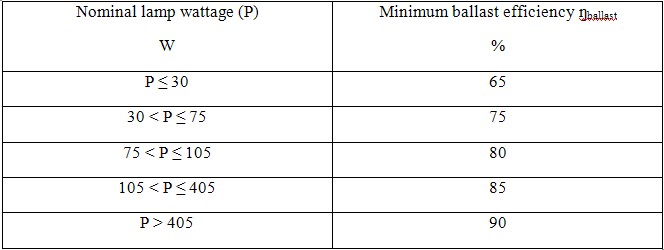
• Also the energy consumption of the ballast of the fluorescent lamps shall not exceed 0.5W when the lamp is not emitting any light.
- Eight years after the ‘Commission Regulation (EC) No 245/2009 of 18 March 2009’ has come into force ballast for high intensity discharge lamps shall have the efficiencies not less than in the following table.
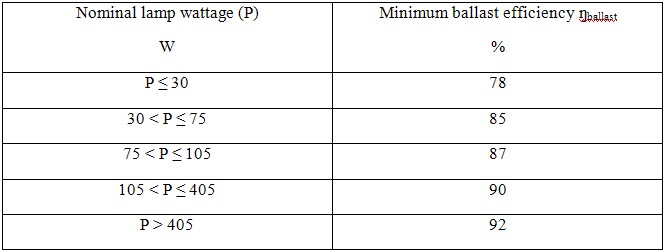
• Requirements concerning information about ballasts:
- One year after the ‘Commission Regulation (EC) No 245/2009 of 18 March 2009’ has come into force the ballasts producers shall provide the following information on generally available internet web pages or any other appropriate media about their ballasts. Also the same information shall be delivered in the technical documentation with the product.
• Energy efficiency index (EEI)


Where: EbbFL is efficiency base ballast

• Requirements concerning luminaire energy performances:
- One year after the ‘Commission Regulation (EC) No 245/2009 of 18 March 2009’ has come into force energy consumption of the luminaires of the fluorescent lamps without inbuilt ballasts shall not exceed the energy consumed by the ballasts when the lamps which are supplied by them do not emit any light.
• Requirements concerning information about luminaires:
- Eighteen months after the ‘Commission Regulation (EC) No 245/2009 of 18 March 2009’ has come into force the luminaires producers shall provide the following information on generally available internet web pages or any other appropriate media about their luminaires for the fluorescent lamps without inbuilt ballast which have more than 2000 lumens . Also the same information shall be delivered in the technical documentation with the product.
• When the luminaire have an inbuilt ballast the manufacturer shall provide the information about ballasts.
• When the luminaire is sold with the lamp the manufacturer shall provide lamps efficacy.
• If the luminaire is not sold with any lamp or ballast the manufacturer shall provide an information which lamps and ballasts are compatible with the luminaire.
• Disassembly instruction.
• Requirements concerning non-directional household lamps energy performances:
Following tables present requirements for non-directional household lamps. The foregoing values are not employed for light bulbs with S14,S15 and S19 caps.


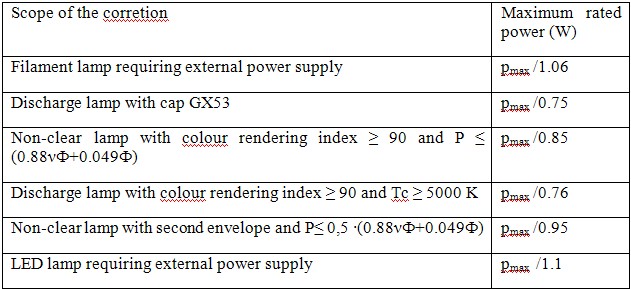
• Requirements concerning non-directional household lamps functionality:
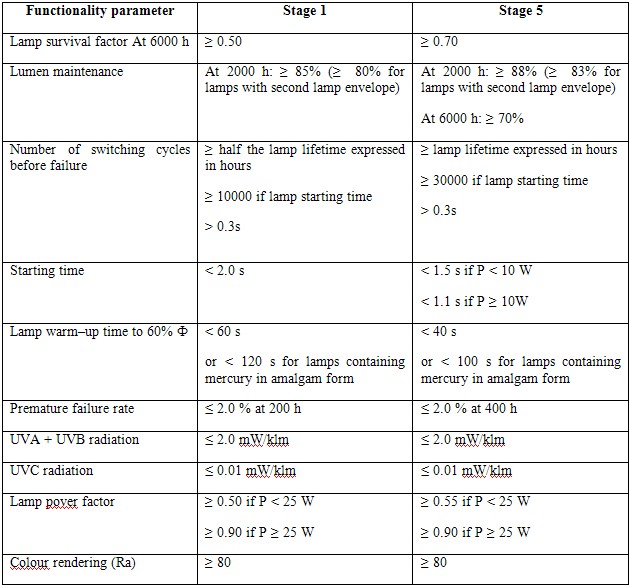
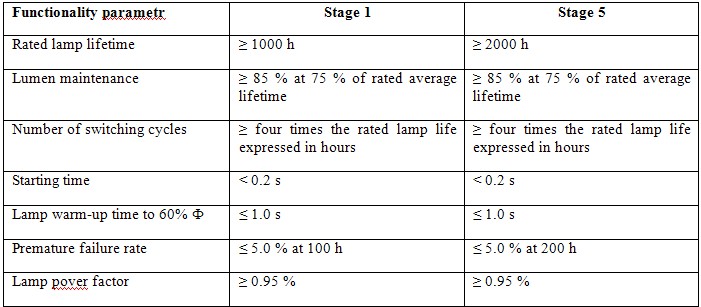
• Requirements concerning information about non-directional household lamps:
- The information shall be delivered on the box of the product and on the generally available manufacturers web site.
- The list bellow contains the information which have to be delivered on the box of the product. They do not have to be listed in an exact form presented below, they can be for example in form of pictures or symbols.
• If the nominal power of the lamp is not displayed on the energy label nominal luminance flux shall be added with font two times bigger than the values displayed outside the label.
• Nominal life time of the lamp displayed in hours.
• Number of switching cycles.
• Color temperature of the lamp.
• time of warm-up of the lamp up to 60% of the full light output.
• An appropriate warning if the lamp cannot work with the dimmer or any kinds of ballasts.
• If the lamp is designed to work in non-conditions an appropriate warning shall be added.
• Lamps length and width in millimeters.
• If there is an equivalence with an incandescent lamp information on the box the value shall be counted to 1W. Table Q22 presents luminous flux of the lamps and the claimed incandescent bulb power.
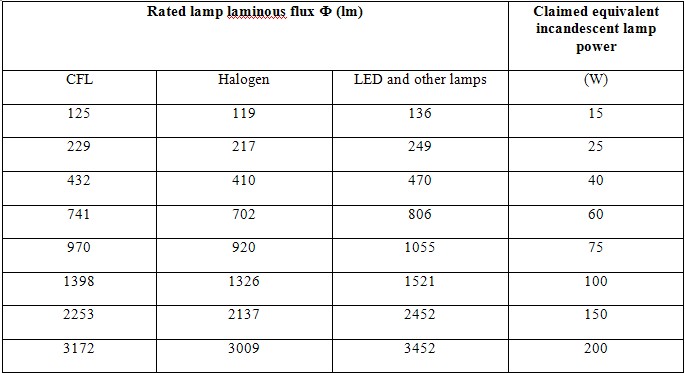
• Mercury occurrence as [x.x mg].
• Indication which website contains the information about how to deal with the lamps debris.
- Information on generally available web sites are listed below:
• All the information presented on the boxes
• Nominal power rounded to 0.1W.
• Nominal luminous flux.
• Nominal lamp life time.
• Lamps power factor.
• Lumen maintenance factor at the end of the life time.
• Starting time as [0.0s].
• Color rendering.
• Information about how to deal with the lamps debris.
-
Definition of energy conservation and demand side management|
Technologies|
Financial funds|
Legislative and normative issues|
Data base
Copyrights © Arkadiusz Mysiakowski
